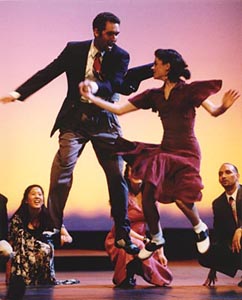

The American Spirit of Creativity and Crossover
Richard Powers
Americans have long emphasized creative personal expression in their dancing, along with the informal adaptation of steps from one dance into another, known as crossover.
It seems that the prototypical American dancer is more intent on bending the rules than adhering to them. I should clarify that I'm not saying that the American approach
is better than others, only different.
WAY BACK WHEN
Until the 20th century, Americans emulated the European prototype, and did their best to dance and dress in the styles of London and Paris. They were painfully aware that
Europeans considered them rough-hewn and socially unskilled. This changed at the beginning of the 20th century, with a prevailing American sentiment to make a clean break
with the past and be progressive. The lore of the American pioneers, with their independence and freedom, was popular at that time, and the ragtime music of rural African
Americans was rapidly gaining enthusiasts. Americans grew less embarrassed about their differences from European culture, and increasingly proud of their uniqueness.
They also began to feel comfortable with their identity as a melting pot of diverse cultural influences, as American music and dance became a synthesis of European, African,
Caribbean and Latin American influences.
At the turn of the century, Paris and London were still considered to be the supreme arbiters of culture and good taste. So when both the French and English became wildly fond
of American ragtime music and dance, between 1900 and 1914, this gave an official seal of approval to Americans' creativity. Since this break from the rules and formalities of European culture,
Americans have never looked back.
After centuries of European dominance of social dance forms, most 20th century social dances came from the Americas — Lindy hop/swing, foxtrot/quickstep, Charleston evolving into hip hop,
blues, hustle and club two-step. Tango, samba, mambo, salsa and cha-cha, from South America and Cuba, shared this Western spirit of creativing and crossover.
There were significant European contributions to exhibition dance forms for stage,
in ballet, flamenco, Irish step dancing and more, but most of the innovations in social dance came from the Americas.
AND TODAY
This American tradition of creativity and crossover is still alive. "Traditional" dance does not mean "old," because traditions continue to evolve. To merely collect
the steps created by others, perhaps by learning a swing step that Frankie Manning invented in 1935, is missing the point of creativity. The way to capture the authentic
spirit of American vernacular dance is to participate in the ongoing evolution oneself. To truly learn from Frankie Manning's example, emulate his creative process, not
just his steps. American dance is innovative in spirit and multicultural in its influences. Creativity and crossover are its trademarks.
More thoughts and musings

